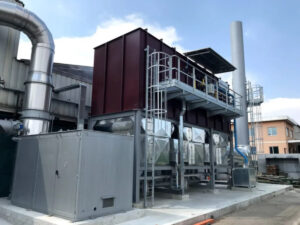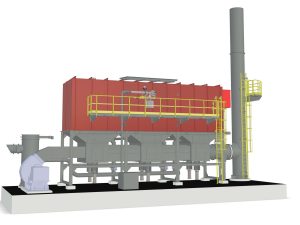- Automotive painting: VOC emission purification plants
- Automotive sector: VOC emissions into the atmosphere
- Automotive paint plants: environmental impact
- Purification targets
- VOC paint: the technical solution applied
- 5-chamber regenerative thermal oxidizer operation
- Automotive sector: dedicated plant solutions
- Automotive paint treatment: the results
- Go to the gallery with all our systems
Automotive paint VOC emission purification
Regenerative thermal oxidation is a valid solution for treating emissions containing VOCs released into the atmosphere during painting processes, in order to comply with atmospheric emission limits; it can be successfully applied in the car painting sector, thus limiting the environmental impact of the production process and also presenting interesting possibilities for energy recovery.
Automotive painting: VOC emission purification plants
Brofind has successfully applied this technology at one of Europe’s most important car manufacturers, at a car body painting line capable of producing around 60 vehicles/hour. The plant has been designed so that it can be expanded at a later date, in order to guarantee the treatment of emissions even following an increase in production, and is equipped with a heat recovery unit capable of pre-heating the air used in the baking ovens of the production process
Automotive sector: VOC emissions into the atmosphere
During the analysis phase, it emerged that the emissions generated by the plant’s painting lines had the following characteristics:
| VARIABLE | FEATURES |
|---|---|
| Temperature | 130 – 150 °C (downstream dedusting processes) |
| Pollutant composition in the emission | Acetates, ketones, esters, aldehydes, aromatic compounds |
| Air flow rates | 50,000 Nm3/h (first phase) – 100,000 Nm3/h (after expansion) |
| Produciton cycle | On several daily shifts |
| Variability | Limited |
Automotive paint plants: environmental impact
The painting process involves the application of several layers of paint products in the spray booth, which can be either water-based or solvent-based; the products applied give the resistance characteristics and aesthetic properties that must last for the life of the vehicle. Base, finish and clear protection layers can be applied, which must undergo a drying process in special baking ovens that can lead to the release of hot air emissions into the atmosphere characterized by the presence of VOCs that are harmful to health beyond the limits set by current regulations and olfactory disturbance.
Purification targets
The purification target is:
- to reduce VOC emissions into the atmosphere as much as possible, well below the emission limits imposed by current regulations, eliminating odour nuisance through a solution that is both environmentally and economically sustainable and capable of recovering the energy required in the production process.
- enable the expansion of the purification plant following the increase in production capacity, which resulted in the addition of 2 more painting line
VOC paint: the technical solution applied
Considering the need to design a flexible solution that could be expanded in size, a 3-chamber regenerative thermal oxidation plant was installed, which was later extended to 5 chambers following an increase in production capacity.
5-chamber regenerative thermal oxidizer operation
Inside the thermal oxidizer, each regenerative chamber contains a ceramic bed that has the function of storing heat, which is heated or cooled depending on the direction of the flow of the emission to be treated.
The pollutant-laden emission to be purified reaches the first chamber (i.e., after the expansion, the first two) and, passing through the ceramic bed heated during the previous phase, is brought to a temperature as close as possible to the reaction temperature (which is approximately 850 °C).
The reaction temperature is maintained by auto-combustion of the contaminants in the emission, which, being VOCs, have a good calorific value, but can also be controlled by the introduction of auxiliary fuel in the heating transients.
The emission to be treated remains at combustion temperature for a residence time sufficient to completely oxidize the pollutants it contains.
After leaving the combustion chamber, the purified emission flows vertically from top to bottom through the second chamber (i.e. the third and fourth, after expansion). The average duration of these process intervals is variable and automatically regulated by a logic specially developed by Brofind according to its own industry-specific know-how.
The third (fifth, after expansion) chamber, on the other hand, allows for further treatment of the incompletely treated emission, which could be conveyed directly to the stack during flow reversal.
Automotive sector: dedicated plant solutions
The application of thermal regenerative anodising technology on automotive painting lines involved the identification and application of specific technical solutions aimed at achieving the following objectives:
- Minimum consumption of auxiliary fuel due to regenerative preheating to treat
- Extremely low generation of secondary contaminants
- Design susceptible to subsequent plant expansion, thanks to a specially designed modular layout
- recovery of excess thermal energy, which was reused for preheating the air used in baking ovens
- compliance with the high quality construction standards and customer specifications that characterize all of its production facilities
- possibility of performing thermal cleaning of ceramic masses automatically and safely, due to the presence of pollutants potentially fouling the system
Automotive paint treatment: the results
-
The achievement of pollutant concentration values in atmospheric emissions well below regulatory limits and the disappearance of odour nuisances
-
The minimisation of energy consumption, thanks to high-efficiency energy recovery
-
The reduction of energy consumption related to baking ovens, thanks to the preheating of air obtained from the excess colour made available by the oxidizer
-
No interference with the thermal and fluid-dynamic conditions of the upstream firing furnaces
-
The successful expansion of the plant following the increase in production capacity after the first installation

